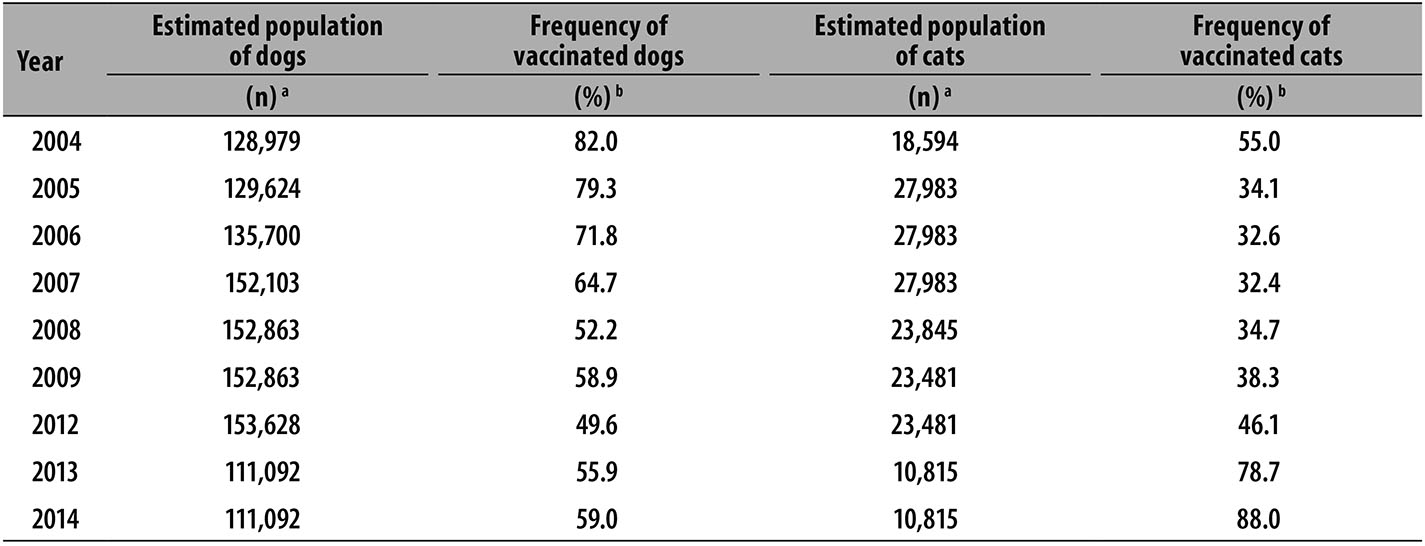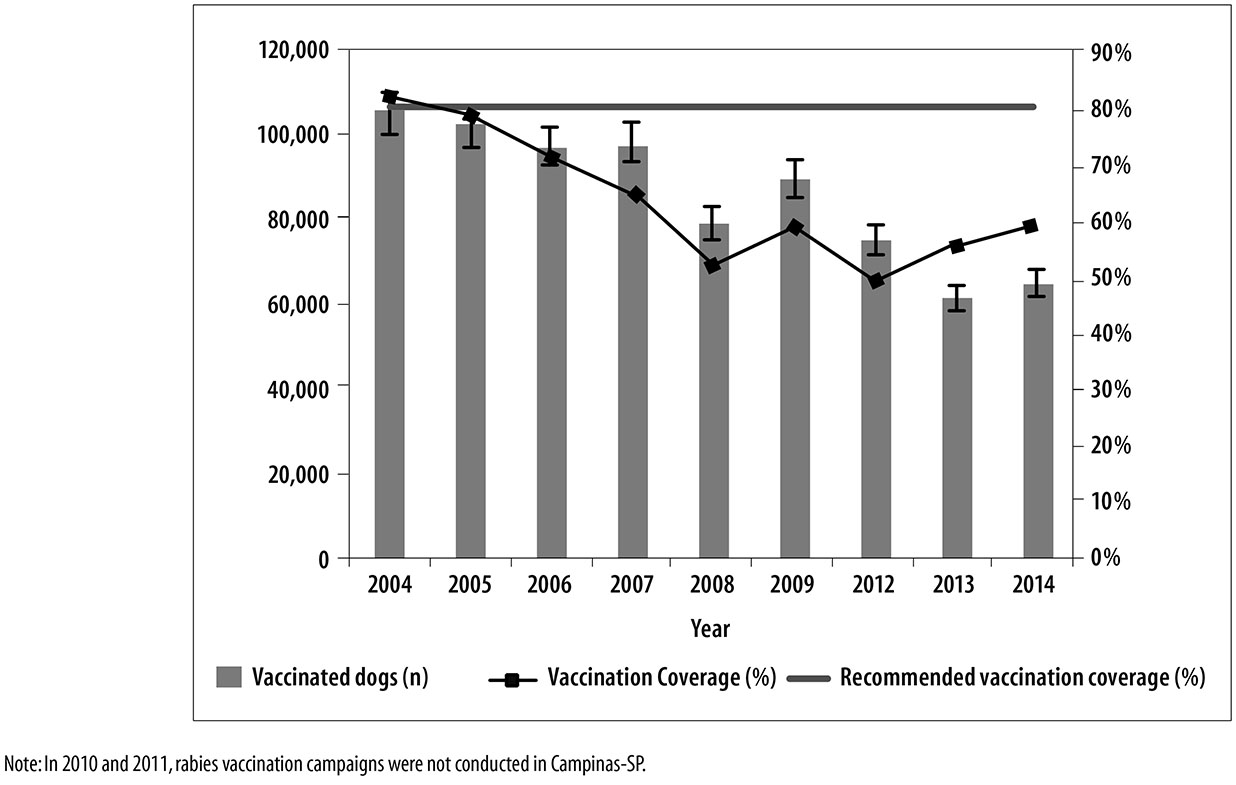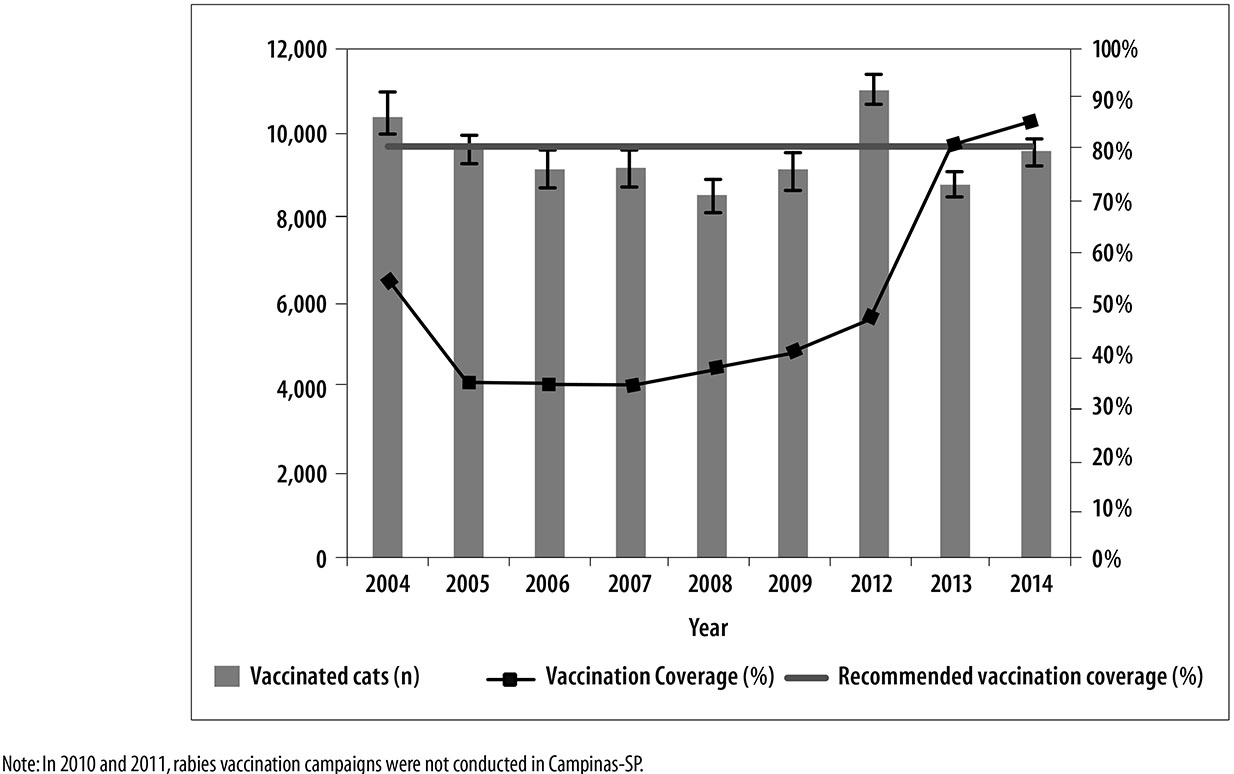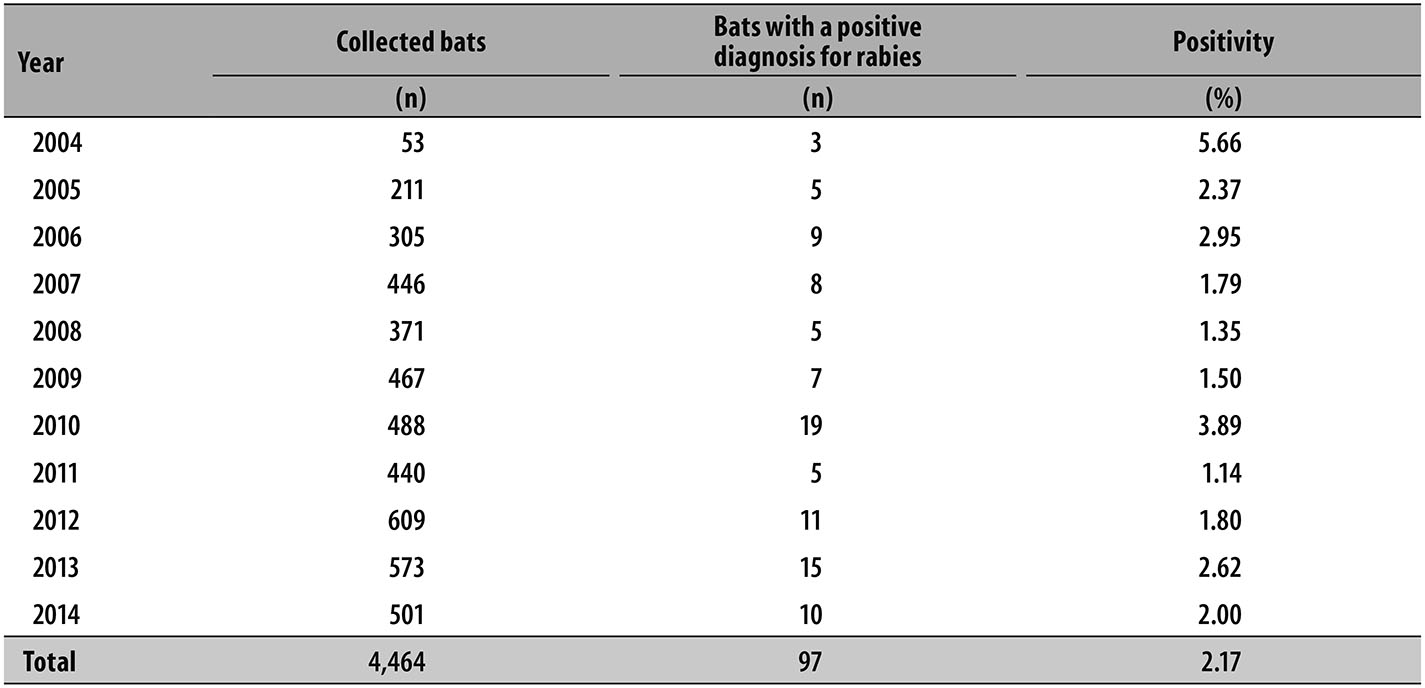Servicios Personalizados
Revista
Articulo
Indicadores
-
 Citado por SciELO
Citado por SciELO
Links relacionados
-
 Similares en
SciELO
Similares en
SciELO
Compartir
Epidemiologia e Serviços de Saúde
versión impresa ISSN 1679-4974versión On-line ISSN 2337-9622
Epidemiol. Serv. Saúde v.26 n.3 Brasília jul./sep. 2017
http://dx.doi.org/10.5123/s1679-49742017000300019
Experience report
Rabies vaccination campaigns in dogs and cats, and rabies positivity in bats, from 2004 to 2014, in Campinas, São Paulo, Brazil
1Secretaria de Saúde do Município de Campinas, Unidade de Vigilância de Zoonoses, Campinas-SP, Brasil
2Secretaria de Saúde do Município de Campinas, Departamento de Vigilância em Saúde, Campinas-SP, Brasil
3Conselho Regional de Medicina Veterinária de São Paulo, Comissão de Saúde Pública, São Paulo-SP, Brasil
OBJECTIVE:
to describe the results of rabies vaccination campaigns in dogs and cats from 2004 to 2009 and from 2012 to 2014, and the positivity for rabies in bats from 2004 to 2014, in Campinas-SP, Brazil.
METHODS:
a descriptive study was carried out with secondary data from the Zoonoses Surveillance Unit.
RESULTS:
there was a marked reduction in the number of vaccinated dogs, from 105,764 (2004) to 65,561 (2014), with vaccine coverage below 80%, except in 2004; there was little oscillation in the number of vaccinated cats, from 10,212 (2004) to 9,522 (2014), with vaccine coverage below 80%, except in 2014; 4,464 bats were collected by passive surveillance, 2.17% of them were positive for rabies.
CONCLUSION:
the low vaccine coverage in dogs and cats and the circulation of the virus in bats imposes the need for improvement in surveillance actions, in order to prevent cases of human rabies.
Keywords: Rabies; Epidemiological Surveillance; Vaccination; Immunization Coverage; Epidemiology, Descriptive
Introduction
Rabies is a viral encephalitis, of zoonotic characteristics and with a fatality rate close to 100%,1 caused by a ribonucleic acid virus (family Rhabdoviridae, genus Lyssavirus), with mammals being the only animals susceptible to the disease.2 More frequently, the infection of the organism by the rabies virus happens through bites or scratches on the intact skin.3
In the state of São Paulo, the last case of human rabies, with a canine isolated viral variant, happened in 1997. In the following year, the last case of canine rabies caused by this viral variant was registered and, since then, the cases diagnosed in humans and animals have been caused by viral variants from bats.4 In Campinas, a municipality in São Paulo State, the last case of human rabies was registered in 1981.5
Nowadays, the disease has been transmitted through the “air cycle”, in which bats, hematophagous or not, keep the virus circulation among domestic pet animals, such as dogs and cats, and domestic animals of economic interest, such as bovines and equines.6 Therefore, a passive surveillance of bats is performed as an important surveillance activity of this disease.7
In 2014, in Campinas, there was a case of the disease in a cat,8 15 years after the last register of rabies in animals of this species. In 2015, a dog was diagnosed with rabies. The last occurrence for animals of this species had been registered in 1982.9 According to the Pasteur Institute, in both cases, the identified viral variants were originated in bats (bat variant Nyctinomops, in the cat’s case;10 and variant 3, of hematophagous bats Desmodus rotundus, in the dog’s case).9 Such facts alerted the local surveillance to the possibility of rabies transmission to humans, fact already described in Dracena, also in São Paulo State, where, in 2001, a woman died after being attacked by her cat, which was infected by a viral variant derived from bats.6
One of the important pillars of the rabies surveillance program proposed by the Ministry of Health is the annual vaccination campaign against rabies in cats and dogs, in order to maintain, in short term, a significant portion of these populations immune to the virus. These campaigns began with the creation of the National Rabies Prophylaxis Program (PNPR), in 1973. The advent of PNPR made the number of rabies cases in dogs and cats reduce significantly. However, to this day, the distribution of human cases remains heterogeneous, with higher incidences in the North and Northeast regions of the country.4,11 However, municipalities of the South (Capão do Leão, in Rio Grande do Sul), Southeast (Campinas, Ribeirão Preto and Jaguariúna, in São Paulo) and Midwest (Goiânia, Goiás’ capital; and Corumbá and Ladário, in Mato Grosso do Sul) also registered rabies cases in dogs and/or cats, between 2014 and 2015.12
In Campinas, in addition to the annual vaccination campaign, other activities for rabies surveillance have been conducted in order to avoid cases in humans and domestic animals. Among these activities, we can highlight the collection of dogs and cats from areas of risk, shipment of samples of animals suspected of encephalopathy for laboratory analysis, ten-day clinical observation of dogs and cats suspected of having the disease and/or causing it in humans, referral of victims of the disease for prophylaxis, blockage of hotbeds in areas where rabies positive animals were found, passive surveillance of bats collected from situations of risk, and observation and vaccination of dogs and cats in contact with bats.13,14
In 2014, the rabies vaccination campaign in Campinas took place in 327 vaccination units. This campaign aims to achieve minimum vaccination coverage of 80% (in dogs and cats), so rabies can be controlled.5 However, year after year, a reduction in the number of vaccinated dogs has been noticed.
The objective of the present article was to describe the results of rabies vaccination campaigns in dogs and cats from 2004 to 2009 and 2012 to 2014, and rabies positivity in bats from 2004 to 2014, in the municipality of Campinas, in São Paulo State, Brazil.
Methods
This is a descriptive study on rabies vaccination campaigns in dogs and cats and rabies positivity in bats from 2004 to 2014. The data were obtained from the analysis of secondary data collected and tabulated by the Zoonoses Surveillance Unit from Campinas. It is important to highlight that, in 2010, vaccination campaigns were suspended throughout the country after the occurrence of adverse reactions associated to the administration of the immunobiological.15 In Campinas, the campaign was resumed in 2012.16 Therefore, vaccination coverage from 2010 to 2011 was not analyzed.
Campinas is a city located in the Northeast region of São Paulo State; it had a population of 1,173,370 inhabitants in 201617 and occupies an area of 796.4km2.18
The variables selected to compose this study were: (i) the absolute number of dogs and cats vaccinated in rabies vaccination campaigns; and (ii) the estimated proportion of vaccinated animals, considering the estimated canine and feline population.
The population estimates of dogs and cats throughout the studied period were determined by the Coordination of the Program for Rabies Control in São Paulo State (CEPCR/SP) and provided to the municipalities in the years of the vaccination campaigns. From these data, the percentages of vaccination coverage for dogs and cats for each year of the time series were calculated. They were obtained from the ratio between the number of vaccinated dogs and cats in each year and the estimated population of each species for that same year, multiplied by 100.19
The absolute number of bats collected annually, through passive surveillance, that is, in situations suspected of rabies, found in unusual places and/or hours, was also considered. These bats, collected by the municipal Zoonoses Surveillance Unit, were sent to the Pasteur Institute of São Paulo-SP for rabies laboratory diagnosis. Rabies positivity in the bat population corresponded to the ratio between the number of positive bats and the total number of examined animals, multiplied by 100.
The data was analyzed using the Microsoft® Office Excel® 2010 program.
The study’s project, conducted with secondary data from the Zoonoses Surveillance Unit was exempt from approval by the Ethics Research Committee, according to the Resolution of the National Health Council (CNS) No. 510, dated April 7th, 2016.
Results
In 2004, the estimated canine population in Campinas was of 128,979 animals. In the following years, the estimates oscillated between 129,624 (2005) and 153,628 dogs (2012). In 2013 and 2014, the same amount of dogs was estimated for each year: 111,092. The population of cats oscillated throughout the years of 2004-2012, with numbers higher than 18,000 animals. In 2013 and 2014 (as it happened to canines), the same amount of felines, 10,815, was estimated for each year (Table 1).
Table 1 - Estimated population of dogs and cats and frequency of vaccinated dogs and cats in the rabies vaccination campaigns conducted in the municipality of Campinas-SP, 2004-2009 and 2012-2014

a) Estimates distributed to the municipalities by the Coordination of the Program for Rabies Control in São Paulo State (CEPCR/SP)
b) Secondary data by the Zoonoses Surveillance Unit from Campinas, obtained through the ratio between the number of vaccinated dogs and cats in each year and the estimated population of each species in the same year, multiplied by 100.
In Figures 1 and 2, the amount of vaccinated dogs and cats in Campinas and their respective vaccination coverage, in the 2004-2009 and 2012-2014 periods, are presented.

Figure 1 - Absolute number of vaccinated dogs and rabies vaccination coverage (%) in the city of Campinas-SP, 2004-2009 and 2012-2014

Figure 2 - Absolute number of vaccinated cats and rabies vaccination coverage (%) in the municipality of Campinas-SP, 2004-2009 and 2012-2014
With regard to dogs, 2004 was the year with the highest number of vaccinated animals: 105,764 vaccinated dogs. In that year, the highest vaccination coverage of the evaluated time series was reached (82%). Since 2006, the vaccination no longer reached 100 thousand dogs in each year, the worst result being in 2013, when only 62,122 animals were vaccinated, and the worst vaccination coverage was in 2012 (49.6%) (Figure 1).
The number of vaccinated cats oscillated between 8,297 (2008) and 10,833 (2012). The vaccination coverage of felines, up to 2012, was below 60%. The lowest vaccination coverage of these animals occurred in 2007 (32.4%), and the highest in 2014 (88.0%) (Figure 2).
Between 2004 and 2014, the Zoonoses Surveillance Unit collected 4,464 bats (annual average of 405 bats), of which 97 tested positive for rabies (average of 8.8 per year; standard deviation = 4.0;13.2). Rabies positivity was of 2.17%, varying from 5.66% (2004) to 1.14% (2011) (Table 2).
Discussion
From 2004 to 2014, there was a marked reduction in the number of vaccinated dogs in Campinas. For animals of this species, vaccination coverage was only above 80% in 2004. Regarding cats, there was little oscillation in the number of vaccinated animals throughout this period. Vaccination coverage remained low until 2012; however, they drastically increased in 2013 and 2014 as the feline population estimations decreased.
With the increase in the number of animals captured found in situations of risk and sent to laboratory analysis, especially since 2012, we can notice advances in the last decade, regarding surveillance actions of rabies transmitted by bats. Once the rabies virus is present in the “air cycle”6, systematic surveillance of bats found in suspicious situations is fundamental.
In Campinas, the average positivity for rabies verified in bats resemble those found in another study, performed in 235 municipalities from the North and Northwest São Paulo State, from 1997 to 2002, in which 7,393 bats were tested, with a positivity of 1.3%.20 Another study, conducted in 60 municipalities from São Paulo State, from 1996 to 2004, showed that this positivity only exceeded 2% in rare occasions: for example, in 2002, in the region of Presidente Prudente, after the incidence of a human case of the disease.21 The positivity observed in Campinas was influenced by the number of bats diagnosed in 2004 (3 cases, among 53 collected animals) and in 2010 (19 cases, among 488 collected animals).5
Successive reductions in the number of vaccinated dogs over the assessed period raises a reflection regarding the possible causes that could justify them. One of the hypotheses would be the fact that there was no rabies in dogs in the municipality for decades, giving the false perception, by part of the population, that the vaccine would no longer be important for the maintenance of the current epidemiological framework. Another hypothesis to be considered is that the lack of vaccination campaigns in 2010 and 2011 would have discouraged the population from taking their animals to subsequent campaigns, or would have left the population fearful, since in some municipalities where the campaigns were conducted in 2010, the press announced some news of serious adverse effects and death of dogs and cats post-vaccination.
As of 2012, with the restoration of vaccination campaigns in Campinas, even more marked reductions in the number of vaccinated dogs were observed. A possible explanation for this would be the fact that, since that year, the campaigns started to be conducted without a standardized schedule, that is, in different months each year, in accordance to the recommendations of the CEPCR/SP, which, in turn, depended on receiving the immunobiologicals from the Ministry of Health. Thus, the campaign was conducted on May, 2012, September, 2013 and October, 2014.16,22 In 2015, there was no rabies vaccination campaign in the municipality. This lack of standardization of dates could have contributed to the lower adherence by the population, because, traditionally, in Campinas, these vaccination campaigns happened in the month of September.
Many work strategies have been implemented in the last decade during the vaccination campaigns in Campinas: mobile teams performed home vaccinations in households with a large number of animals; the number of vaccination units increased; teams of vaccinators were qualified; teams with veterinarians were selected to assist adverse reactions; and the internet was used to announce vaccination centers. These strategies aimed to qualify the campaign and increase rabies vaccination coverage.
According to literature data, dog vaccination coverage varying between 60 and 80% should prevent rabies transmission among those animals.23 According to Coleman and Dye, a vaccination coverage of 70% would avoid a rabies epidemic in 96.5% of the situations analyzed by them.24
However, there are some doubts left about the real vaccination coverage in Campinas during the evaluated period, considering that this coverage depends on dogs and cats population estimates, which have oscillated considerably throughout the last decade and may have influenced the vaccination coverage analysis.
Percentages of vaccination coverage are inversely proportional to dogs and cats population estimates. As of 2013, there was a calculation readjustment in the animal population estimates, since some municipalities considered them to be overestimated.25 The result was larger vaccination coverage, even if a smaller number of animals had been vaccinated if compared to the 2012 campaign. This difference can be noticed when we cross-check the year of 2012 (before the readjustment) with 2013 and 2014. For dogs, if the population estimate of 2012 was kept, the vaccination coverage would be of 40.4% (2013) and 42.6% (2014), against the 55.9% and 59.0% verified for those same years. Even if there was a reduction in the population estimates, vaccination coverage would still be below the recommended 80%. For cats, if population estimate of 2012 was kept, the vaccination coverage would be of 36.2% (2013) and 40.5% (2014), lower than the recommended 80%, against the 78.7% and 88.0% verified for these last two years.
Two studies carried out in the state of São Paulo aimed to measure the population of dogs and cats. When performing a measurement of the state’s population of dogs and cats, Alves et al. obtained the following results: ratio dog:inhabitant = 4.0; and ratio cat:inhabitant = 16.4.26 In the municipality of São Paulo-SP, Canatto et al. found a ratio dog:inhabitant = 4.34 and a ratio cat:inhabitant = 19.33.27 If the method of information attainment of the studies aforementioned is taken into consideration, using as a source of population data the estimates provided by the Brazilian Institute of Geography and Statistics (IBGE) for Campinas in 2016,17 the minimum results obtained for this municipality would be of 270,361 dogs and 60,702 cats, quantities way above the population of dogs and cats estimated in 2014.
Knowing the number of dogs and cats vaccinated by the city’s private network is also of utmost importance. This amount, added to the number of doses administered throughout the campaign, would allow the municipality to understand - for real - the total amount of vaccinated animals. This same knowledge would be essential for planning the resources to be obtained by the municipality for performing the campaign. The knowledge about the number of needed vaccination units, per area, allows a dimensioning of resources (teams and inputs) proportional to the needs of the population and its animals. So far, there is no information concerning the amount of vaccines administered by the private healthcare sector.
Efforts should be directed towards an efficient estimate of the population of dogs and cats in the municipality, in order to generate safe information on vaccination coverage of these animals against rabies. It would also be important to determine a minimum vaccination coverage to be obtained so Campinas could minimize the chances of rabies cases in dogs and cats, at the current epidemiological scenario (absence of cases of the canine variant), as well as if the vaccination campaign remains as an effective strategy.
Given the rabies epidemiological situation in Campinas, it seems more suitable to intensify other surveillance strategies and the control of this disease, both in its human prophylactic scope - considering the observation of dogs and cats responsible for diseases and the opportune indication of prophylaxis conducts - and its environmental aspect, with the implementation of vaccination and surveillance actions on dogs and cats in contact with bats, in addition to expanding the passive surveillance of the bats themselves.
Feline and canine rabies cases registered in 201410 and 20159 show that the disease is present and can affect humans and domestic animals in Campinas. This municipality must be prepared to foresee situations of risk and perform appropriate surveillance actions, with the goal of minimizing risks of infection in humans and domestic animals.
Referências
1. Wada MY, Rocha SM, Maia-Elkhoury ANS. Situação da raiva no Brasil, 2000 a 2009. Epidemiol Serv Saude. 2011 out-dez;20(4):509-18. [ Links ]
2. Instituto Pasteur. Profilaxia da raiva humana. 2 ed. São Paulo: Instituto Pasteur; 2000. (Manual Técnico do Instituto Pasteur, 4). [ Links ]
3. Ministério da Saúde (BR). Secretaria de Vigilância em Saúde. Departamento Vigilância Epidemiológica. Doenças infecciosas e parasitárias: guia de bolso. 8 ed. Brasília: Ministério da Saúde; 2010. (Série B. Textos básicos de saúde). [ Links ]
4. Moretti GMA. Estudo da campanha de vacinação contra a raiva em cães e gatos em área do município de São Paulo, SP [dissertação]. São Paulo: Universidade de São Paulo; 2013. [ Links ]
5. De Lucca T, Rodrigues RC, Castagna C, Presotto D, De Nadai DV, Fagre A, et al. Assessing the rabies control and surveillance systems in Brazil: an experience of measures toward bats after the halt of massive vaccination of dogs and cats in Campinas, Sao Paulo. Prev Vet Med. 2013 Aug;111(1-2):126-33. [ Links ]
6. Instituto Pasteur. Raiva: aspectos gerais e clínica. São Paulo: Instituto Pasteur; 2009 (Manual Técnico do Instituto Pasteur, 8). [ Links ]
7. Instituto Pasteur. Manejo de quirópteros em áreas urbanas. São Paulo: Instituto Pasteur; 2003 (Manual Técnico do Instituto Pasteur, 7). [ Links ]
8. Dias RA, Baquero OS, Guilloux AG, Moretti CF, De Lucca T, Rodrigues RC, et al. Dog and cat management through sterilization: implications for population dynamics and veterinary public policies. Prev Vet Med. 2015 Nov;122(1-2):154-63. [ Links ]
9. Secretaria Municipal de Saúde (Campinas). Informe epidemiológico: campanha de vacinação contra a raiva em cães e gatos, 2016 [Internet]. Campinas: Secretaria Municipal de Saúde; 2016 [citado 2017 jan 10]. Disponível em: Disponível em: http://www.saude.campinas.sp.gov.br/vigilancia/informes/2016/Informe_Epidemiologico_Campanha_Antirrabica_2016.pdf [ Links ]
10. Castilho JG, Souza DN, Oliveira RN, Carnieli Júnior P, Batista HBCR, Pereira PMC, et al. The epidemiological importance of bats in the transmission of rabies to dogs and cats in the state of São Paulo, Brazil, between 2005 and 2014. Zoonoses Public Health. 2016 Nov;1-8. [ Links ]
11. Schneider MC, Almeida GA, Souza LM, Morares NB, Diaz RC. Controle da raiva no Brasil de 1980 a 1990. Rev de Saude Publica. 1996 abr;30(2):196-203. [ Links ]
12. Ministério da Saúde (BR). Secretaria de Vigilância em Saúde. Departamento de Vigilância de Doenças Transmissíveis. Coordenação Geral de Doenças Transmissíveis. Unidade Técnica de Zoonoses. Mapas da raiva no Brasil - 2014 [Internet]. Brasília: Ministério da Saúde; 2014 [citado 2016 jan 29]. Disponível em: Disponível em: http://portalsaude.saude.gov.br/images/pdf/2015/junho/08/MAPAS-ATUALIZADOS-RAIVA-2014 [ Links ]
13. Instituto Pasteur. Vacinação contra a raiva em cães e gatos. São Paulo: Instituto Pasteur; 1999 (Manual Técnico do Instituto Pasteur, 3). [ Links ]
14. Ministério da Saúde. Secretaria de Vigilância em Saúde. Departamento de Vigilância de Doenças Transmissíveis. Coordenação Geral de Doenças Transmissíveis. Nota técnica 19/2012. Diretrizes da vigilância em saúde para atuação diante de casos de raiva em morcegos em áreas urbanas. Brasília: Ministério da Saúde; 2012. [ Links ]
15. Secretaria de Estado da Saúde (São Paulo). Coordenadoria de Controle de Doenças. Instituto Pasteur. Informe Técnico. Vacina contra a raiva canina e felina. 3 de março de 2011. São Paulo: Instituto Pasteur; 2011. [ Links ]
16. Secretaria de Estado da Saúde (São Paulo). Coordenadoria de Controle de Doenças. Instituto Pasteur. Informe Técnico. Vacina contra a raiva canina e felina no Estado de São Paulo. 17 de fevereiro de 2012. São Paulo: Instituto Pasteur; 2012. [ Links ]
17. Instituto Brasileiro de Geografia e Estatística. Cidades. São Paulo: Campinas [Internet]. Rio de Janeiro: Instituto Brasileiro de Geografia e Estatística; 2015 [citado 2016 jan 29]. Disponível em: Disponível em: http://www.cidades.ibge.gov.br/xtras/perfil.php?lang=&codmun=3509502 [ Links ]
18. Secretaria Municipal de Planejamento e Desenvolvimento Urbano (Campinas). A cidade. Dados geográficos [Internet]. Campinas: Secretaria Municipal de Planejamento e Desenvolvimento Urbano; 2017 [citado 2017 jan 13]. Disponível em: Disponível em: http://www.campinas.sp.gov.br/governo/seplama/dados-do-municipio/cidade/ [ Links ]
19. Ministério da Saúde. Secretaria de Gestão Estratégica e Participativa. Departamento de Articulação Interfederativa. Cadernos de diretrizes, objetivos, metas e indicadores: 2013 -2015. Brasília: Ministério da Saúde; 2013. [ Links ]
20. Cunha EMS, Silva LHQ, Lara MCCSH, Nassar AFC, Albas A, Sodré MM, et al. Raiva em morcegos na região norte-noroeste do Estado de São Paulo, Brasil: 1997-2002. Rev Saude Publica. 2006 dez;40(6):1082-6. [ Links ]
21. Secretaria de Estado da Saúde (São Paulo). Raiva em morcegos em áreas urbanas no Estado de São Paulo. Bol Epidemiol Paulista. 2005 ago;2(20):7-9. [ Links ]
22. Secretaria de Estado da Saúde (São Paulo). Coordenadoria de Controle de Doenças. Instituto Pasteur. Ofício Circular IP DG 026-2014. Campanha de Vacinação 2014. 08 de julho de 2014. São Paulo: Instituto Pasteur; 2014. [ Links ]
23. Grisi-Filho JHH, Amaku M, Dias RA, Montenegro Netto H, Paranhos NT, Mendes MCNC, et al. Uso de sistemas de informação geográfica em campanhas de vacinação contra a raiva. Rev Saude Publica. 2008 dez;42(6):1005-11. [ Links ]
24. Coleman PG, Dye C. Immunization coverage required to prevent outbreaks of dog rabies. Vaccine. 1996 Feb;14(3):185-6. [ Links ]
25. Secretaria de Estado da Saúde (São Paulo). Coordenadoria de Controle de Doenças. Instituto Pasteur. Nota Técnica 02. Populações de cães e gatos: readequação para 2013. 07 de outubro de 2013. São Paulo, SP: Instituto Pasteur; 2013. [ Links ]
26. Alves MCGP, Matos MR, Reichmann ML, Dominguez MH. Dimensionamento da população de cães e gatos do interior do Estado de São Paulo. Rev Saude Publica. 2005 dez;39(6):891-7. [ Links ]
27. Canatto BD, Silva EA, Bernardi F, Mendes MCNC, Paranhos NT, Dias RA. Caracterização demográfica das populações de cães e gatos supervisionados do município de São Paulo. Arq Bras Med Vet Zootec. 2012 dez;64(6):1515-23. [ Links ]
Received: September 21, 2016; Accepted: March 02, 2017











 texto en
texto en 



